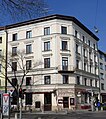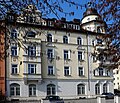Maillingerstrasse
| Maillingerstrasse | |
|---|---|
| Street in Munich | |
| Maillingerstraße, looking north with the Bavarian LKA (right) | |
| Basic data | |
| State capital | Munich |
| Townships | Maxvorstadt , Neuhausen-Nymphenburg |
| Name received | 1886 |
| Connecting roads | Mars Street |
| Cross streets | Nymphenburger Strasse , Blutenburgstrasse, Elvirastrasse, Rupprechtstrasse |
| U1 / U7 | Maillingerstraße underground station |
| use | |
| User groups | Pedestrian traffic , bicycle traffic , individual traffic |
| Technical specifications | |
| Street length | 400 m |
The Maillingerstraße is a street in the Munich districts Maxvorstadt and Neuhausen . It connects Nymphenburger Straße with Marsstraße running in a north-south direction . It has been named after the Bavarian general and war minister Joseph Maximilian von Maillinger since 1886 . Today Maillingerstraße is a traffic-calmed side street.
Listed buildings
In the street at number 11-13 there was formerly a Marstall barracks . In 1979, a three-story extension was built at Maillingerstraße 11 for the state salary office. The Bavarian State Criminal Police Office has been located there since 1968 , which was built on the site of the artillery barracks, into which part of the listed former Marstall barracks at Maillingerstraße 15 (monument number D-1-62-000-4157) was integrated. This building and five other four to five- story apartment buildings on Maillingerstraße are listed as historical monuments . It refers to
- a four-storey apartment building from the year of construction 1893, with a facade in a late Classicist structure at Maillinger Straße 2 with the monument number D-1-62-000-4153,
- a four-storey tenement house built around 1890 as exposed brick with plaster structure in neo-Renaissance forms at Maillingerstraße 9 with the monument number D-1-62-000-4154,
- a five-storey tenement house at Maillingerstraße 12, completed around 1880, in the late classicist style with the monument number D-1-62-000-4156,
- a four-storey tenement house built around 1900 at Maillingerstraße 32, designed as a corner building with bay windows and octagonal dome tower , monument number D-1-62-000-4158, and
- a four-storey apartment building built around 1900 as a corner building in the architectural style of the German Renaissance at Maillingerstraße 34, D-1-62-000-4159.
history
The Bavarian industrialist Georg Krauss founded the locomotive factories Krauss & Comp. On June 17, 1866 on the Marsfeld in Munich-Neuhausen . It was painted by Friedrich Perlberg in 1882 . The factory was ultimately located at Maillingerstraße 33. The administration building built there in 1922/23 was sold to the Deutsche Reichsbahn .
The composer Carl Orff was born in 1895 at Maillingerstraße 16 and lived there until October 1939.
From 1924 on, the Grünsfelder brothers owned a metal wholesaler at Maillingerstraße 23, the former bell foundry of Ulrich Kortler (1846–1928). They emigrated to the United States in the course of Aryanization in Munich .
Areas formerly belonging to Maillingerstraße were renamed Helmholtzstraße in 1965/67 (the Munich ATEGE -Lager II at Maillingerstraße 73 became Helmholtzstraße 15), other areas were added to the new Marsstraße . The street leading from Marsstraße was initially called Has (s) langstraße from 1890 , named after the Bavarian field marshal, from 1947 Baudrexelstraße , named after the master builder Josef Baudrexel (1861–1943). The state salary office located next to it was house number 2. This was assigned to Maillingerstraße 11 after integration into the new building of the state criminal investigation office.
In 1995, the Consulate General of the Republic of Bosnia and Herzegovina was briefly located at Maillingerstraße 32 .
cartography
In the Munich map of the 4th edition of Meyers Konversationslexikon (1888) Maillingerstrasse is partially shown. The area of today's even house numbers 2 to 24 appears to be built up. In the Munich map of the 14th edition of the Brockhaus Konversations-Lexikons (1891), the entire Maillingerstraße can be seen, further developed and including the locomotive factory and infantry barracks.
Traffic history
From October 21, 1876, the first line of Munich's horse-drawn tram ended here from the Promenadeplatz to the later so-called “Burgfrieden-Maillingerstraße” stop in Nymphenburger Straße , the forerunner of the electric tram .
Today's traffic connection
In the vicinity of Maillingerstraße on Nymphenburger Straße is the Maillingerstraße underground station, which opened on May 8, 1983, on the lines U1 / U7 of the Munich underground .
Individual evidence
- ^ A b Christian Lankes, Wolfram Funk : Munich as a garrison in the 19th century: the capital and residence city as the location of the Bavarian army from Elector Max IV. Joseph until the turn of the century, Mittler , 1993, p. 162 [1]
- ↑ Bea Betz, Anita MF Schrade, Thomas Schabel, Bund Deutscher Architekten Bayern: Architekturführer Bayern, Süddeutscher Verlag , 1985, p. 49 [2]
- ↑ The history of the Bavarian State Criminal Police Office , PDF file, p. 2
- ↑ Archive for Criminology , Volumes 141–143, 1968, pp. 63/64 [3]
- ↑ List of monuments for Munich (PDF) at the Bavarian State Office for Monument Preservation, PDF file, p. 521
- ↑ a b List of monuments for Munich (PDF) at the Bavarian State Office for Monument Preservation, PDF file, p. 500
- ↑ Gerhard Neumeier, Munich around 1900: Living and working, family and household, districts and social structures, homeowners and factory workers, demography and mobility. Studies on the social and economic history of a major German city before World War I , 1995, p. 405.
- ↑ picture online
- ^ Albert Gieseler, Power and Steam Engines: Lokomotivfabrik Krauss & Comp. AG
- ↑ Handbook of German Stock Companies, Volume 48, Part 6, 1943
- ↑ Christian Lankes, Wolfram Funk : Munich as a garrison in the 19th century: the capital and residence city as the location of the Bavarian Army from Elector Max IV. Joseph until the turn of the century , Mittler , 1993, p. 503 online .
- ↑ Wolfram Selig, "Aryanization" in Munich. the annihilation of Jewish existence 1937-1939 , 2004, p. 534.
- ^ Munich and its buildings after 1912, 1984, p. 457
- ↑ The Federal Republic of Germany, State Handbook, Partial Edition of the Federation, 1995
- ↑ 140 years of the tram in Munich , PDF file, p. 2
- ↑ Maillingerstraße underground station at www.u-bahn-muenchen.de , accessed on January 16, 2017
- ↑ Maillingerstrasse station plan
Coordinates: 48 ° 8 ′ 54 ″ N , 11 ° 32 ′ 42 ″ E





